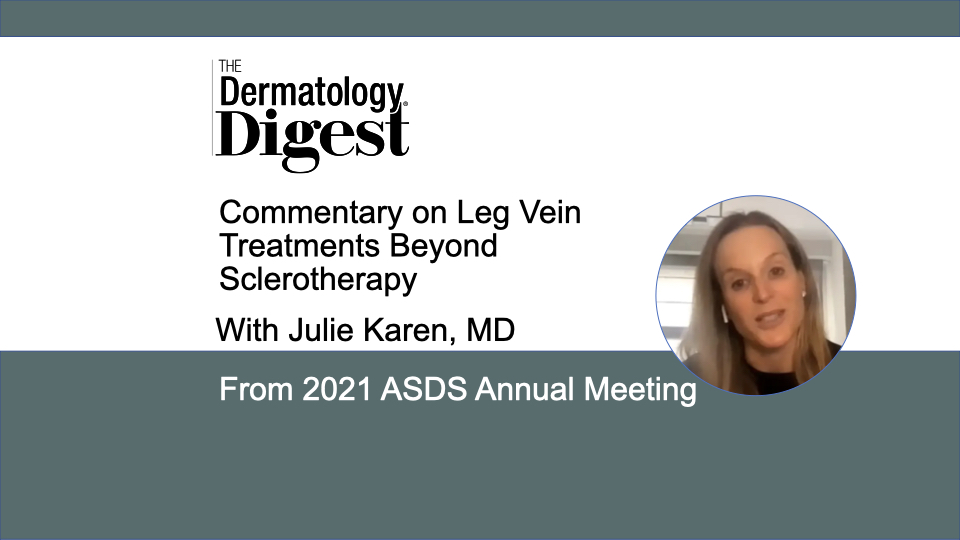Dr. Julie Karen discusses the signs and symptoms of venous insufficiency and tips for successful leg vein treatment.
Julie Karen, MD, is Clinical Assistant Professor of Dermatology at New York University Langone Medical Center, and Co-Founder, Co-Director of CompleteSkinMD in New York City.
“When someone does not have underlying venous insufficiency and they just have spider vein and reticular veins… very often those can be very readily treated with sclerotherapy. Sclerotherapy has become an integral component of our residency training programs,” said Julie Karen, MD, who presented “Beyond Sclerotherapy” as part of the Vein Treatment session at the 2021 American Society for Dermatologic Surgery (ASDS) Annual Meeting.
“There’s a quick learning curve, it’s easy to use, it can be fun to do, and very gratifying.”
However, sclerotherapy isn’t always the appropriate treatment. Key to effective leg vein treatment is identifying possible underlying venous insufficiency, said Dr. Karen.
“First and foremost, you should suspect that there could be underlying venous insufficiency, meaning backward flow within the vessels of our legs, that puts pressure on the visible veins and that would preclude effective treatment with sclerotherapy.”
Symptoms of venous disease include aching, swelling, cramping, edema, fatigue, heaviness, and restless legs, said Dr. Karen.
“If you have a patient who is reporting symptoms of venous disease… any or all of those symptoms can indicate an underlying venous condition. If you suspect it, you want to either perform an ultrasound or refer the patient for an ultrasound.”
According to Dr. Karen, another sign of an underlying venous problem is bulging varicose veins in specific zones of the saphenous system.
“Patients may not report symptoms often because these symptoms are insidious. They have occurred over many years and decades and patients have acclimated to their symptoms and they may have learned to ignore them.”
The great saphenous vein begins in the medial ankle, continues up the medial calf and thigh, ending in the groin area where it meets the femoral vein.
“If someone has bulging veins or many veins in that medial distribution, you want to consider that maybe they have great saphenous venous insufficiency, and if you just try to patch up the visible veins with sclerotherapy, you’re not going to have success.”
Another system to consider during assessment is the small saphenous venous system. This system begins at the posterior lateral aspect of the ankle, continues up the midline of the posterior calf, and ends at or around the knee, said Dr. Karen.
“If someone has a bulging vein on the posterior aspect of the leg, you might want to suspect that they need to get an ultrasound because perhaps they have venous insufficiency.”
Other signs of venous insufficiency that may warrant an ultrasound include a strong family history of venous disease, poor sclerotherapy response, and previous venous surgery, said Dr. Karen.
“That’s the most important thing—who might need underlying investigation; who might need, therefore, endovenous laser ablation to treat those underlying problems or even just ultrasound guided sclerotherapy injections to treat the feeding vessels that are causing the visible concerns.”
Although infrequently required, alternative treatments are available for patients who are not good candidates for sclerotherapy.
“If you have a patient who is terrified of needles [and] faints every time you go near them, someone who gets ocular migraines every time you inject their vessels, someone who just isn’t getting better with sclerotherapy and [you] rule out underlying disease, sometimes then we will utilize percutaneous lasers, such as the Nd:YAG or the pulsed dye laser.”
Although lasers are not as effective as sclerotherapy, which is considered the gold standard treatment, they can be helpful for some patients, said Dr. Karen.
Because leg veins are often a patient’s primary concern, Dr. Karen encourages other dermatologists to attend one of the hands-on sessions offered at educational meetings such as the ASDS Annual Meeting or AAD Annual Meeting.
“[Leg vein treatment] can provide tremendous relief and satisfaction for patients and translate into a very rewarding patient-physician relationship.”


